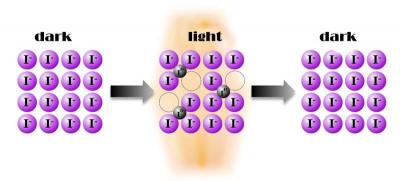Researchers at the Max Planck Institute for Solid State Research have found that in a certain perovskite, light not only releases electrons, but also electrically charges atoms. This novel photoeffect is said to be extremely large - ion conductivity increased by a factor of one hundred. For solar cells made from this material, the high light-induced ion conductivity is rather damaging but the consequences can be counteracted. The researchers find the effect ground-breaking in itself, as it makes novel, light-controlled electrochemical applications conceivable, such as batteries directly charged by light.

The research team has examined how light influences the transport of electricity in materials based on the perovskite methylammonium lead iodide (MAPI). In their experiments, the researchers observed that ions, or charged atoms, contribute to conductivity to an unexpectedly high degree when the material is illuminated. Light that influences ion transport has previously been demonstrated in biology: Illumination is able to indirectly alter the permeability of a cell membrane. "Very surprising, however, is the fact that the ionic conduction of crystalline solids can be directly modified and to what extent this is possible," says the research team.
The team used various methods to prove the effect beyond any doubt. In an initial experiment, they used electrical contacts for MAPI that blocked ions, that is, they allowed only the electrons to pass. They used a specific current and measured the voltage. If ions are involved in the current flow, the voltage should increase after a short time, because they can only move initially, but are then blocked by the contacts. This was exactly what the researchers observed.
Clear evidence of ionic conduction was also provided by the voltage measured in an open circuit, which was generated by the researchers using the perovskite as the electrolyte phase of an illuminated battery cell: if electrons in the material primarily transported current, a short circuit would occur, and no voltage would be produced. However, using an ionically conductive material as the electrolyte, the anticipated battery voltage can be measured.
The researchers directly demonstrated iodine transport in two further experiments. They exposed one side of the perovskite to gaseous iodine. They attached a copper film to the other side, which acts as a so-called iodine sink because of its propensity to react to form copper iodide. Under illumination, this process occurred at very high speed. Transport of the iodine within the perovskite sample was also demonstrated by an experiment in which toluene acted as an outer sink for the element. The researchers demonstrated spectroscopically that the iodine concentration in the toluene increased as soon as the perovskite was illuminated.
The mechanism observed by the team is reversible. It does not destroy the material. Only when the perovskite material is in contact with a substance that bonds iodine permanently, or when iodine escapes into the atmosphere, does the material degrade over time.
In the near future, the researchers intend to investigate the effect itself, because it represents a novelty in solid-state research. "We will examine other materials to see if similar phenomena occur". The researchers are also focusing on the question of how this effect can be exploited technically. "Ionic conductivity represents a key phenomenon in an energy research context", "But in many respects ' especially when it comes to exposure to light ' it remains terra incognita." The Max Planck researchers in Stuttgart intend to change this.

